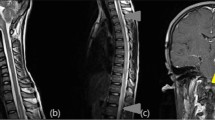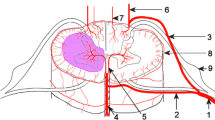Abstract
Background
Longitudinally extensive transverse myelitis (LETM) is characterized by spinal cord lesions that affect at least three spinal cord segments. It can be associated with various inflammatory conditions. While imaging characteristics can aid in diagnosis, relying solely on them may lead to misinterpretation.
Case presentation
We describe a 35-year-old woman who presented with subacute myelitis. Her cervical MRI (magnetic resonance imaging) revealed an extensive lesion from the area postrema down to the second thoracic level, with a trident sign observed in axial T1-weighted post-gadolinium imaging. The presence of a trident sign in MRI of patients with myelopathy is more commonly associated with sarcoidosis than other conditions. But our patient had positive (rechecked) AQP4 antibody and negative FDG-PET (fluorodeoxyglucose positron emission tomography) scan that shows trident sign could be seen in other inflammatory disorders such as NMO (neuromyelitis optica).
Conclusion
Trident sign is not pathognomonic for sarcoidosis, additional investigations are necessary to identify the diagnoses related to the trident sign.
Similar content being viewed by others
Background
Longitudinally extensive spinal cord lesions(LESCL) or longitudinally extensive transverse myelitis(LETM) represent a rapidly progressive and extensive spinal cord involvement, with abnormal T2 signal traversing at least three vertebral body segments in length. Aquaporin 4(AQP4) seropositive neuromyelitis optica spectrum disorder (NMOSD) is the most common cause of both monophasic (50%) and recurrent (93%) LETM [1]. But LETM can be seen in several other conditions, including myelin oligodendrocyte glycoprotein (MOG) associated encephalomyelitis, autoimmune glial fibrillary acidic protein (GFAP) astrocytopathy, systemic illness (neurosarcoidosis, Sjögren syndrome, systemic lupus erythematosus (SLE), Behçet disease, paraneoplastic myelitis) and other causes such as idiopathic (AQP4 negative), post-infectious and vascular (spinal cord infarction or dural arteriovenous fistula (dAVF) [2, 3].
Herein, we report a case of LETM that showed a positive AQP4 with a trident sign in axial T1-weighted brain magnetic resonance imaging (MRI) with contrast. The trident sign in MRI can help differentiate between various etiologies of myelopathy, but further investigations are needed to confirm the diagnosis.
Case presentation
A previously healthy female patient, aged 35 years, was referred to the neurology clinic with a complaint of four limbs weakness on January 1st, 2023. She reported painless progressive upper and lower extremities weakness and paresthesia that started two weeks before the first visit. Also, she developed urinary incontinence five days before the first visit. She denied any history of respiratory or gastrointestinal infection before the event. Her habit was insignificant. She was not smoker, did not consume alcohol and denied any previous recreational drug use. Additionally, there is no family history of neurological disorders. In neurologic examination muscle force of both upper and lower limbs was 0/5 accompanied by an increased deep tendon reflex (+ 3) and bilateral Babinski sign. All sensory examination was impaired in extremities; however, no sensory level was found. The abdominal cutaneous reflex was absent. The initial laboratory results and chest X-ray were normal. A T2-weighted MRI(1.5T MRI Scanner, Amira, Siemens, Germany) of the cervical and thoracic spine revealed LETM that extended from the area postrema down to the T2 level, resulting in cord expansion (Fig. 1A), and a bright spot lesion (BSL) on axial view was found (Fig. 1C). Gadolinium injection showed a ring-like enhancement in sagittal view (Fig. 1B), and a characteristic trident sign in axial view, indicating a dorsal aspect of the cord and posterolateral white matter involvement (Fig. 1D). The brain MRI revealed no specific pathologic finding, but cerebrospinal fluid (CSF) analysis showed zero cells with a protein level of 74 mg/dL and a glucose level of 67 mg/dL, with no organism was detected in Gram's staining. Oligoclonal band (OCB) and Angiotensin-converting enzyme (ACE) levels in CSF were undetectable. Serological testing for the antinuclear antibody, antiphospholipid antibodies, ACE, as well as viral markers were unremarkable. Neither adenopathy nor evidence of pulmonary involvement was detected in a spiral chest CT scan. Whole body FDG-PET (Siemens, Germany) showed no evidence of hypermetabolic potentially malignant or granulomatous lesion, while the AQP4 antibody was positive on serum assessment. Normal FDG-PET ruled out sarcoidosis and we treated our patient with NMOSD diagnosis. Treatment with 1 gr intravenous corticosteroid daily for five days and plasma exchange for five sessions was started and followed by oral prednisolone at 50 mg. Rituximab initiated on day 40 of her admission. On day 30 of admission, muscle forces improved to 4/5 and 1/5 for the upper and lower limbs, respectively. Moreover, a follow-up MRI of the cervical spine revealed less contrast enhancement (Fig. 1E, F). On one-month follow-up after discharge, she could ambulate with a walker.
Sagittal T2-weighted MRI shows LETM starting from area postrema up to second thoracic vertebra level (A), T1 with contrast demonstrates a ring enhancement (B). A bright spotty lesion and trident sign are observed in axial T2-weighted and post-contrast T1 images (C, D). Follow-up imaging shows improvement in lesion loads in T2-weighted and less enhancement in T1 post-contrast MRI (E, F)
Conclusion
LETM is a characteristic feature of NMOSD, but extensive spinal lesions can also occur in other autoimmune and inflammatory diseases that involve the CNS [4]. According to the history and imaging findings, the differential diagnosis is NMOSD, Myelin oligodendrocyte glycoprotein antibody-associated disease (MOGAD), or sarcoidosis. A bright spotty lesion on the cervical MRI of our patient is one of the MRI characteristics that could be suggestive of NMOSD. Sylvain Rabasté and colleagues, in their study on 82 patients with myelopathy, showed that after the first acute spinal cord syndrome, the presence of axial-BSLs on cord MRI seems very specific for NMOSDAQP4 + and can be a radiological marker of AQP4-IgG positivity [5]. A review conducted by Sara Salama and colleagues in 2022 concluded that, the detection of BSLs, whether on axial or sagittal spinal MRI images, provides specificity ranging from 89 to 100% and sensitivity ranging from 26.7 to 69% for NMOSD [6]. Prior studies on Differentiating NMOSD from other causes of LETM based on imaging, showed that the BSLs on axial T2-weighted MRI images are the most distinctive finding of NMO (p < 0.001) [7]. Moreover, the presence of a ‘T1 dark’ signal and lesions involving more than 50% of the spinal cord in the axial cross-sectional area are more frequently found in NMO patients [7].
Zalewski and colleagues reported nine cases of neurosarcoidosis presented with subacute myelitis, whose spinal MRI showed a central canal and dorsal-subpial enhancement in 89%, resembling a trident head on axial sequences. They concluded that Central canal enhancement and the trident sign in subacute myelitis should raise high suspicion for sarcoidosis [8].
Jolliffe EA and colleagues documented a case of myelopathy with a trident sign and a positive ELISA NMO antibody, but a negative result on cell-based assay study. They discovered hilar adenopathy on chest CT scan and considered the possibility of neurosarcoidosis [9]. In our current report, we performed spiral chest CT and FDG-PET scans to rule out sarcoidosis, which yielded unremarkable results. Additionally, our patient had two positive ELISA NMO antibodies and BSL on imaging, making the diagnosis of NMOSD more likely.
In 2023, Griffin K and colleagues reported a case of progressive myelopathy with a trident sign in cervical MRI, but negative AQP4 and MOG antibodies along with FDG-PET. cord biopsy performed due to worsening weakness despite treatment and revealed infiltration by diffuse large B cell lymphoma [10].
In sum, when encountering LETM cases with a trident sign in spinal MRI, NMOSD should be considered as a possible diagnosis while investigating other potential causes.
Availability of data and materials
The principal data gathered during this study are included in this article. The datasets used during the current study are available from the corresponding author on reasonable request. Figure used in the study was original and made by the authors.
Abbreviations
- LESCL:
-
Longitudinally extensive spinal cord lesions
- LETM:
-
Longitudinally extensive transverse myelitis
- NMOSD:
-
Neuromyelitis optica spectrum disorder
- AQP4:
-
Aquaporin 4
- MRI:
-
Magnetic resonance imaging
- CT:
-
Computed tomography
- BSL:
-
Bright spotty lesion
- FDG-PET:
-
Fluorodeoxyglucose-positron emission tomography
- dAVF:
-
Dural arteriovenous fistula
- SLE:
-
Systemic lupus erythematosus
- CSF:
-
Cerebrospinal fluid
- OCB:
-
Oligoclonal band
- ACE:
-
Angiotensin-converting enzyme
- MOGAD:
-
Myelin oligodendrocyte glycoprotein antibody-associated disease
- ELISA:
-
Enzyme-linked immunosorbent assay
References
Jitprapaikulsan J, Chiriboga AS, Flanagan EP, Fryer JP, McKeon A, Weinshenker BG, et al. Novel glial targets and recurrent longitudinally extensive transverse myelitis. JAMA Neurol. 2018;75(7):892–5.
Barnett Y, Sutton IJ, Ghadiri M, Masters L, Zivadinov R, Barnett MH. Conventional and advanced imaging in neuromyelitis optica. AJNR Am J Neuroradiol. 2014;35(8):1458–66.
Shan F, Long Y, Qiu W. Autoimmune glial fibrillary acidic protein astrocytopathy: a review of the literature. Front Immunol. 2018;5(9):2802.
Trebst C, Raab P, Voss EV, Rommer P, Abu-Mugheisib M, Zettl UK, et al. Longitudinal extensive transverse myelitis—it’s not all neuromyelitis optica. Nat Rev Neurol. 2011;7(12):688–98.
Rabasté S, Cobo-Calvo A, Nistiriuc-Muntean V, Vukusic S, Marignier R, Cotton F, et al. Diagnostic value of bright spotty lesions on MRI after a first episode of acute myelopathy. J Neuroradiol. 2021;48(1):28–36.
Salama S, Levy M. Bright spotty lesions as an imaging marker for neuromyelitis optica spectrum disorder. Mult Scler. 2022;28(11):1663–6.
Pekcevik Y, Mitchell CH, Mealy MA, Orman G, Lee IH, Newsome SD, et al. Differentiating neuromyelitis optica from other causes of longitudinally extensive transverse myelitis on spinal magnetic resonance imaging. Mult Scler. 2016;22(3):302–11.
Zalewski NL, Krecke KN, Weinshenker BG, Aksamit AJ, Conway BL, McKeon A, et al. Central canal enhancement and the trident sign in spinal cord sarcoidosis. Neurology. 2016;87(7):743–4.
Jolliffe EA, Keegan BM, Flanagan EP. Trident sign trumps Aquaporin-4-IgG ELISA in diagnostic value in a case of longitudinally extensive transverse myelitis. J MSARD. 2018;23:7–8.
Griffin KJ, Toledano M, Flanagan EP, Mustafa R. “Trident Sign” in primary CNS B-cell spinal cord lymphoma. Neurology. 2023;101(19):857–8.
Acknowledgements
Not applicable
Funding
No funding was received.
Author information
Authors and Affiliations
Contributions
M.Sh: supervision of the study, data acquisition. F.M: the preparation of the manuscript and assisted in the manuscript's radiological section in describing the imaging and writing the pertinent section. M.R: figure creation and edited the final manuscript. A.A participated in rheumatologic consult of patient. S.M: participated in the clinical care of this patient. A.R: data acquisition. M.S: supervision of the study. All authors have reviewed the data analysis process, writing of the manuscript, and approved the final article.
Corresponding author
Ethics declarations
Ethics approval and consent to participate
This study was in accordance with the Shahid Beheshti University of medical sciences research committee's ethical standards (2023/2/10) and with the Helsinki declaration.
Consent for publication
Informed consent was obtained from patient (not applicable).
Competing interests
The authors declare that they have no competing interests.
Additional information
Publisher's Note
Springer Nature remains neutral with regard to jurisdictional claims in published maps and institutional affiliations.
Rights and permissions
Open Access This article is licensed under a Creative Commons Attribution 4.0 International License, which permits use, sharing, adaptation, distribution and reproduction in any medium or format, as long as you give appropriate credit to the original author(s) and the source, provide a link to the Creative Commons licence, and indicate if changes were made. The images or other third party material in this article are included in the article's Creative Commons licence, unless indicated otherwise in a credit line to the material. If material is not included in the article's Creative Commons licence and your intended use is not permitted by statutory regulation or exceeds the permitted use, you will need to obtain permission directly from the copyright holder. To view a copy of this licence, visit http://creativecommons.org/licenses/by/4.0/.
About this article
Cite this article
Shojaei, M., Maghsudloo, F., Ramezani, M. et al. Longitudinally extensive transverse myelitis with trident sign and positive AQP4 antibody: a case report. Egypt J Neurol Psychiatry Neurosurg 60, 70 (2024). https://doi.org/10.1186/s41983-024-00846-4
Received:
Accepted:
Published:
DOI: https://doi.org/10.1186/s41983-024-00846-4





